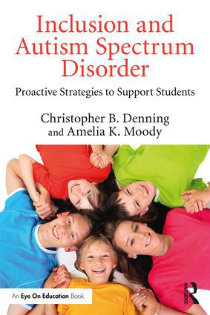Inclusion and Autism Spectrum Disorder
Inclusion and Autism Spectrum Disorder: Proactive Strategies to Support Students
By Christopher B. Denning and Amelia K. Moody
(Routledge/Eye On Education, 2018 – Learn more)

Statistics on the prevalence of Autism Spectrum Disorder (ASD) are getting scary. Christopher B. Denning and Amelia K. Moody don’t go into the whys of the disorder; rather they discuss its increase and what we can do about it.
Studies show a 60% increase in cases from 2006 and a 120% increase from 2002. This increase is why we as teachers should consider learning more about this disorder.

The authors stress the importance for teachers to capitalize on students’ strengths to help remedy the weaknesses. This is really important because most of these students are in inclusive classrooms for at least a part of their day.
How UDL Can Help
With this in mind, the authors go on to describe the Universal Design for Learning. Because UDL principles can be applied to any curriculum, they help support all students and are the best first steps to take. This method allows all children to engage in the material and display their knowledge of this material in different ways.
Denning and Moody go into detail for each of the three components of UDL which are Means of Representation, Means of Expression, and Means of Engagement. A chart of vocabulary words using pictures is an example from the “means of representation” while a choice board for homework is one for “means of engagement.”
Practical ways to provide support
“Establishing an Effective Learning Environment” (chapter 3) suggests using natural settings. For instance, putting a visual clue by the child’s locker can remind him to sign in for attendance. Labeling items and using bins for work completion also falls into this category as well as keeping the work spaces and materials the same to help with the predictability in your classroom.
Academic Supports come in chapter 4 and, as noted before, the authors state that all children have strengths and weaknesses. Children with ASD are no exception. Using their strengths of rote memory and visual skills can assist them in accessing new information and improving understanding. Prompting and reinforcing add a layer of support to help students complete tasks successfully.
After chapter 4 gives broad and general guidelines for support in any area, the authors narrow their focus to the subjects of reading, writing and math. In writing, for example, Denning and Moody target the challenges that are most often seen – handwriting, organization and word retrieval. They suggest three possible areas of support that can help.
Tools to build social interaction
Social skill development is next. Social communication is broken down by the authors so we can pinpoint more accurately where the student needs support. One such area is social-emotional reciprocity which includes back and forth conversations. Lack of skills in this area can cause problems when there is a failure to respond and/or initiate interactions.
The authors suggest teaching and reinforcing skills often. Also it was found to be more effective if the skills were taught in the classroom and on the playground. Behavioral interventions were given in this chapter as well as the next one. They range from naturalistic interventions (a look and listen prompt) to more visual interventions (a stress thermometer).
To close out the book, the authors want everyone to consider the importance of physical movement. Getting enough exercise has been shown to decrease some of the stress and anxiety as well as disruptive behaviors in children, particularly those with ASD.
This informative and thoughtful book is filled with lots of ideas to aid us in lending support for these students.
Joanne Bell is a middle school teacher at St. Joseph Elementary School in Cottleville, Missouri. She currently teaches social studies to sixth and seventh graders and is working on a blog, Thinking Through ADHD.


































